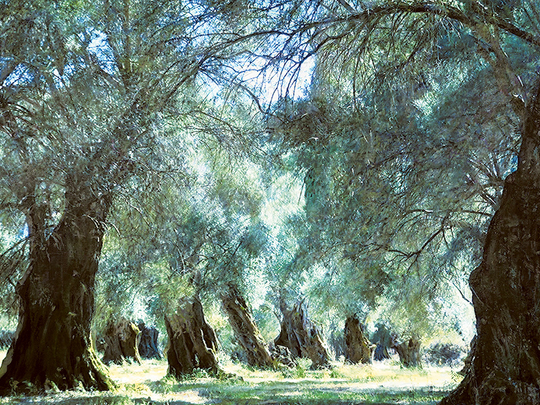
Human beings have always been attracted to images of nature because they offer spiritual comfort and an escape from the stresses of everyday life. The wealthy in ancient Rome commissioned frescoes of idyllic landscapes for their villas. In the 18th and 19th centuries, poets and philosophers such as William Wordsworth, Lord Byron, Percy Bysshe Shelley and Immanuel Kant celebrated the restorative effect of nature in their writings. In modern times, the internet and social media are flooded with photographs and videos of nature, taken by amateurs and professionals who were moved by a particular scene.
Filmmaker Shoja Azari and painter Shahram Karimi tapped into our eternal fascination with nature and the huge archive of nature photography available on the internet to create a series of unique “video paintings” that explore humanity’s relationship with nature. The artworks feature landscape paintings that come alive through the projection of videos on to the canvasses. A selection of these video paintings are on display at Leila Heller Gallery Dubai at an exhibition titled “The Cold Earth Sleeps Below”.
Azari and Karimi were born in Iran and are childhood friends. New York-based Azari is known for making films that explore themes of gender, politics and cultural prejudices. His series of short films, titled “Windows”, premiered at the Tribeca Film Festival in 2005, and he won the Silver Lion for best director at the 2009 Venice Film Festival for “Women without Men”, a film that he co-directed with his wife Shirin Neshat. Karimi lives and works between the US and Germany. He is a painter and poet, whose nostalgic paintings and Farsi poems explore the dilemmas that exist in the contemporary Iranian society.
Karimi has designed the sets for many of Azari’s films, but their collaboration on the video paintings is unique because it combines the classical technique of painting and latest video technology to create a new medium for artistic expression. Their latest work looks at different aspects of nature through two sets of works titled “Dreamscape” and “Consequences”.
To create these works, the artists appropriated clichéd images of nature from the internet and transformed them into something much more beautiful and inspiring. Each composition in the “Dreamscape” series features an idyllic, serene landscape such as a grove of olive trees, cherry blossoms in full bloom, or a field full of wild flowers painted by Karimi. His textured oil and acrylic paintings come alive when Azari’s videos of the same images are projected on the canvases. Viewers can watch the branches and leaves rustling gently in the breeze, and the play of light and shade as the rays of the sun shine through the foliage. The magical, hypnotic artworks evoke a sense of harmony, balance, symmetry and the eternal cycle of nature.
In stark contrast, the images in the “Consequences” series are of natural disasters such as forest fires, hurricanes and melting glaciers, painted with thin washes of watercolour; and the artworks are constructed like a black box theatre where the images must be viewed through a small opening in the wall. These works provide a glimpse of nature as something sublime and powerful by depicting the dangers lurking behind the beauty, the potential storms raging behind the tranquillity, and warning human beings about the consequences of their irresponsible actions. Karimi’s poems written with marker on the canvasses add to the drama.
The handmade paintings, infused with emotion, layered with videos of mechanically reproduced imagery represent a beautiful synthesis of old and new art techniques and materials. By using found images of nature, the artists have created a personal narrative that is based on collective memories, but they have also made a statement about asserting one’s individuality and originality in today’s digital world. The absence of human beings in these landscapes adds a layer of irony to the works.
The exhibition takes its title from the words of a poem by Shelley — “The cold earth slept below/Above the cold sky shone; And all around/The breath of night like death did flow”. The poem is about the beauty of nature, but also about decay and death.
“We chose this title because we wanted to revisit the contemporary relevance of this paradoxical notion of beauty and the sublime that the Romantics fought to free from the clutch of utilitarian materialism, egoism and the rational mind of the 18th century,” the artists say.
Through these video-paintings, Azari and Karimi want to draw attention to the imbalance in our relationship with our environment, sounding a warning about the disastrous consequences of this and questioning the general perception of nature being harmonious, sedate and governable. On another level, by using the landscapes as metaphors for social values and norms, the artists want to invite viewers to think about the perceptions, conventions and beliefs that contemporary society is based on, and the darkness that lurks beyond the surface.
“We see the beautiful not as a placid or comforting manifestation of equilibrium, symmetry or harmony, but as a violent, visceral experience of awe, even terror. With the continuing arrogance, objectification and destruction of nature since the Industrial Revolution, we believe that man might have arrived at a point of no return. Nature is rebelling and is unleashing its great powers of awe and terror. The future of our species, and that of others, is unknown,” the artists say.
Jyoti Kalsi is an arts-enthusiast based in Dubai.
“The Cold Earth Sleeps Below” will run at Leila Heller Gallery Dubai, in Alserkal Avenue, Al Quoz, until September 1.













